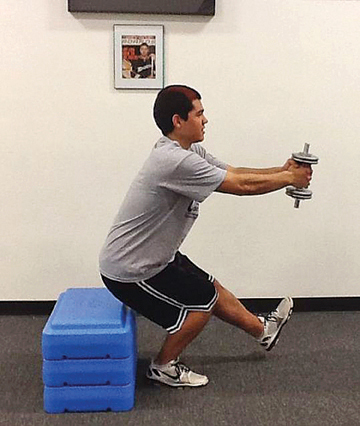For ages, the squat was the most widely used exercise to improve lower body strength. As the strength and conditioning profession has evolved, the emphasis on many programs has switched to single-leg exercises to improve strength, power, stability and performance. This is not to say that the squat should no longer be a part of your strength program, but that the emphasis should be on single-leg strength.
When you look at sports in general, a majority of the time an athlete is on one leg and not two. Whether you are cutting to get by your opponent, skating down the ice or kicking the ball into the net to win the game, these actions take place on one leg. With this in mind, it seems more functional to build athletic strength by performing one-legged exercises.
There are a multitude of benefits to single leg strengthening. It will improve strength in the hips more effectively, which will improve lateral power on the field, court or ice. It develops a more stable and balanced athlete. This increase in stability will help prevent common injuries such as ankle and knee sprains. With single leg lifts, less weight is used, decreasing the axial load on the spine. This will reduce the chance of low back injuries that are commonly seen with squatting heavy weight. With many double-leg exercises, an athlete can use their dominant leg more than the other during the exercises. This can develop an imbalance in strength between the right and left side. The imbalance can lead to future injury if not fixed.
There are many great single-leg strength exercises out there. Here are three exercises that are most commonly utilized. All exercises can be performed in sets of three to five sets of six to 12 repetitions. Begin the exercises without weight. As you master the exercise, begin using an external load such as dumbbells or kettlebells.
Single Leg Bench Squat
The athlete stands on one leg, slowly sitting down until their hips touch the bench and then standing back up. The keys are to set the bench so that the thigh gets parallel to the ground and that the shoulder, hip, knee and foot stay in alignment without any medial (inward) translation.
Rear Foot Elevated Split Squat
The athlete stands on one leg with the back leg up on a bench or box. The athlete lowers his or her body down towards the ground until the thigh is parallel to the floor. The keys are to keep the rear foot pointed out so it does not assist with the squat and that the shoulder hip, knee and foot stay in alignment without any medial translation.
Single-Leg Straight Leg Dead Lift
The athlete stands on a straight leg, reaching down to the ground with the opposite arm as the opposite leg remains straight and raises up until parallel to the ground. The keys are to keep the hips level and the exercise should be felt in the back of the leg and hip, not the low back.
 High School Illustrated High School Sports Magazine
High School Illustrated High School Sports Magazine



